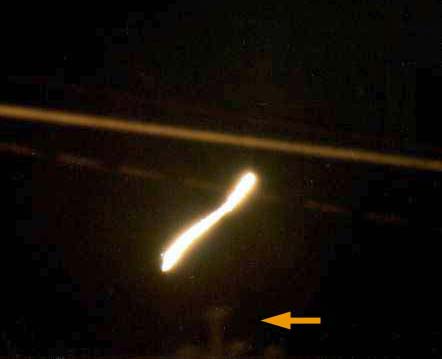
by Bruce Cornet, Ph.D.
EMBLA 2001 : The Optical Mission
|
Table of Contents
Mathematical Calculations and Analysis
Following the performance by an AOP that resembled a Boeing 707 without engines, Cornet waited to see what else would happen that night of 24 September, 1992. He had to wait for another hour, but his patience paid off. At 10:57 pm he saw a bright light (AOP) moving from east to west in the direction of Middletown, NY. That direction was the same direction from which the Boeing-like AOP had traveled three times before. However, this time the AOP was moving west instead of north. It was low to the ground, and obscured by the tops of trees. It appeared to be no further away than about 1/2 mile.
When it got to Rte 211E, it turned north and came directly at Cornet, climbing in altitude as it approached. The first picture (time exposure) he took of it shows a bright golden-white light with aura around it. Evidence is presented on a separate page that this type of light and its aura were produced by a plasma rather than by a conventional lamp. The top of a pine tree in the front yard at Hillside Village can be seen at the bottom of the photograph (arrow). The lines that cross the photograph from left to right are utility wires along Goshen Turnpike, which intersects Rte 211E just to the left of the photo.

A daytime shot of the same area (below) shows the relationship of that pine tree (arrow) to the tops of buildings and trees. The building in the picture is located at the intersection of Rte 211E and Goshen Turnpike.
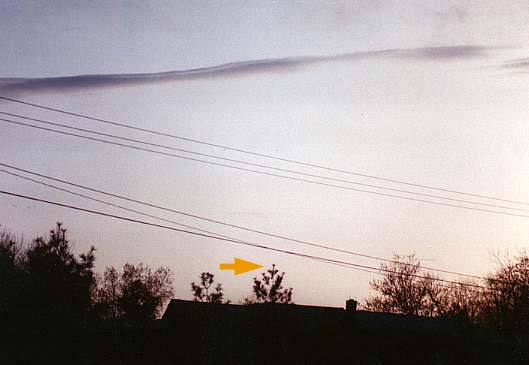
The light appears to be in front of the utility wires, because of its brightness. Due to the collecting power of a camera lens, which focuses light that has diverged with distance from a source, an illusion is created by superposition. And yet, that light could not have been very far away to have been bright enough to mask the utility wires. The next time exposure taken (below) begins to show a gradual transformation of the AOP from a single light to a central light with small satellite lights on both sides.
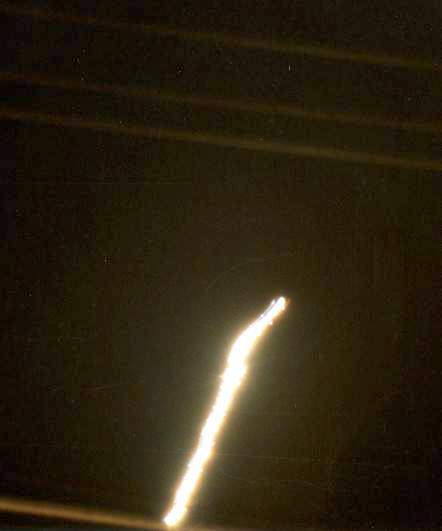
At the top of the light trace small red and greenish blue light traces begin to emerge with white dots (strobes) embedded in them. The red and greenish blue lights continue to evolve in subsequent photographs to resemble wingtip hazard lights on conventional aircraft. However, the color of the greenish blue light is incorrect, and appears more blue than green. The central light and its satellite lights become much more organized and less chaotic in the next image below. This same type of AOP (central light with small satellite lights) was photographed two weeks later at West Searsville Rd., but on that night it did not do a transformation.
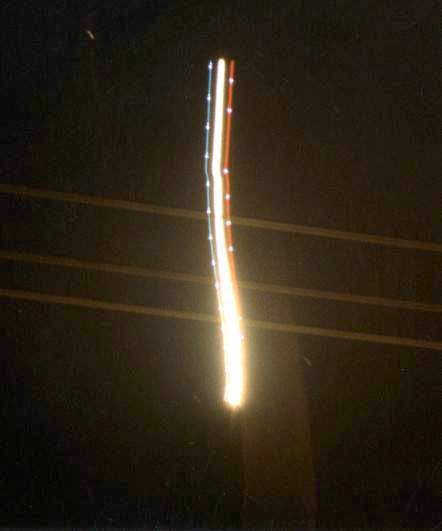
Note the ribbon of brown Nitrous Oxide gas trailing off the right side of the AOP (above). Note also that this brown ribbon disappears as the red and greenish blue lights become better developed. But what is striking about the pattern of strobes embedded in the outer lights is that those on the greenish blue light are doublets and evenly spaced, while those on the red light are single and unevenly spaced. This difference is important, because strobes on conventional aircraft are symmetrical both in number and their firing times. When we examine enlargements of the negatives below, you will see how ridiculous any attempt will be to try and explain this AOP as a conventional aircraft changing its orientation to the camera. That is because the movement of the lights within each trace is a complex of spirals and loops.
The fourth time exposure (below) looks like it was designed for the Fourth of July with patriotic red, white, and blue lights. Note that all three light traces have regular bumps within them. These are the spirals and loops (see below). Note also that the strobes embedded in the now blue light are consistently spaced and are all doublets, while the strobes embedded in the red light contain some doublets and are sometimes very unevenly spaced.
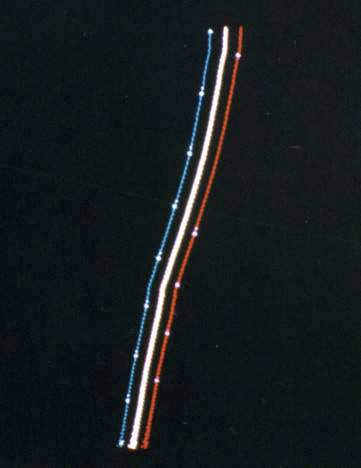
The fifth time exposure (below) shows a further progression in the transformation from a bright single plasma light to lights that resemble those on a conventional aircraft. The bumps within each trace appear to be more spread out. The strobes embedded in the red light trace continue to fire unevenly.
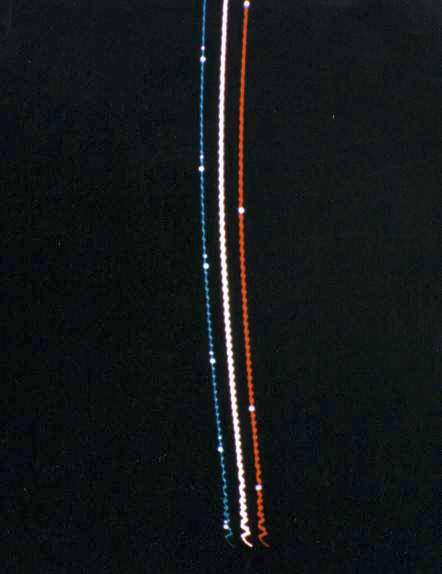
At the beginning of the above traces (bottom of photograph), one can barely make out distinct loops. Upon magnification of the negatives under a microscope, one can clearly see the spiraling nature of the lights and how the spirals evolve into alternating loops. Such light movement precludes this AOP from being identified with any known human aircraft design.
|
|
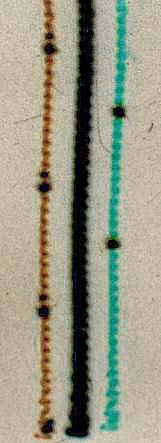 |
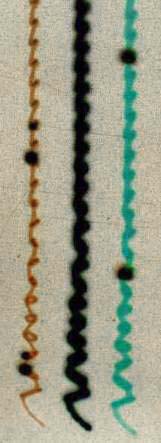 |
Enlargement of loops (below) from the image on the far right in the above set shows that they alternately loop from left to right (top to bottom), a complex feat that rules out camera movement as the cause.
|
A compilation of the first five photographs is given below in order to show the irregular or non-straight path of the AOP, as well as its closeness based on elevation below and above the utility wires. At the end of the seventh time exposure (see below), the AOP was directly above Cornet's position.

The last two photographs taken of this AOP show a continued loss of loops as the light traces become more and more like those of a conventional aircraft. Spiral motion has decreased to a slow twist. When the AOP flew over Cornet, he heard a sound like that made by a single-engine propeller-driven airplane. The blue light had again developed a green hue, and the strobes on both sides were now firing more-or-less regularly.
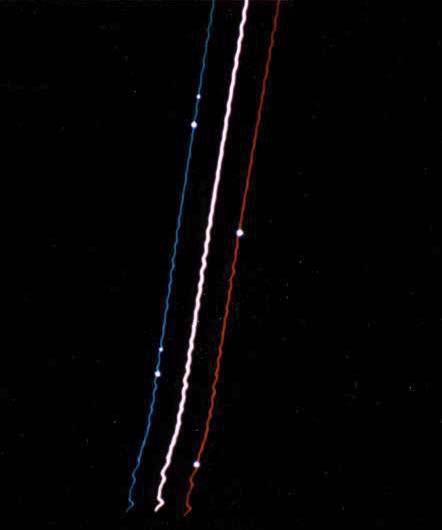
The last photograph (below) shows the left light as almost green, while the red light has faded to almost invisible. It is only at this point in the event that Cornet heard a sound like that of an aircraft engine. Prior to this time the AOP was silent.
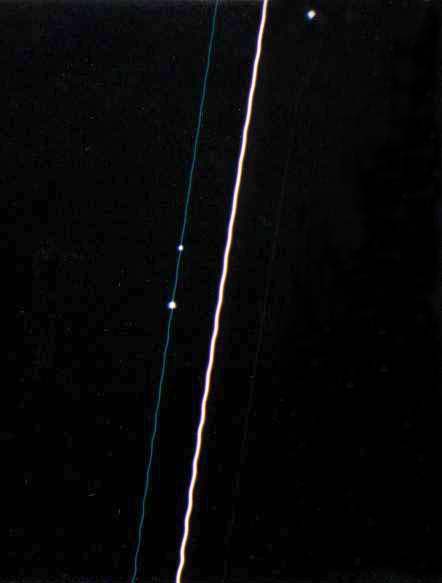
Mathematical Calculations and Analysis
Because the doublet strobes embedded in the greenish blue light seemed to fire regularly, it is possible to graph that light trace for each image by using the number of doublets per length of interval in centimeters (measured off of photograph). If this had been a conventional single-engine airplane, the number of strobes per centimeter would have decreased according to a linear progression, consistent with the law of perspective. Instead of being linear or near-linear, the curve generated by this AOP is a differential curve. In other words, the timing of the strobes was not constant. If it had been constant, computation of distance traveled (using the wingspan of a single-engine plane) would place the AOP at a distance of 1.5 miles from the camera when first photographed. Because light decreases in intensity inversely with the square of distance, the initial brilliance of the AOP should have been brighter than the Sun. A light that bright surely would have been noticed and reported in the news the next day, but no such report was published.
In order to account for this discrepancy, and to account for the apparent distance when first sighted of no more than 0.5 miles, the strobe rate could not have been constant. The strobe firing-rate had to have decreased along a curve similar to the one generated in the graph below:
Graph No. 1, giving detailed calculations for this event.
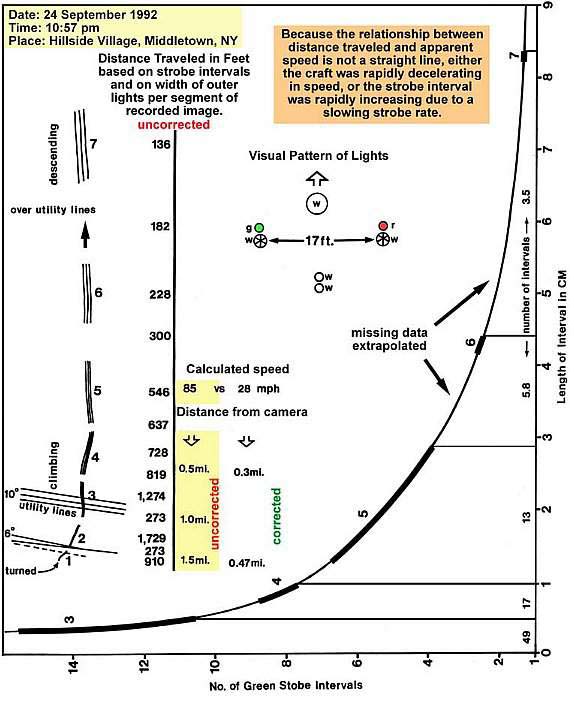
When one graphs the number of oscillations or spirals per green/blue strobe interval, a significant change in the rate of oscillation occurs during the visual transformation from bright light to three colored lights (third photograph). From that point onwards the rate of spiraling decreases much more gradually. Prior to the transformation the lights spiraled so rapidly that individual spirals are impossible to distinguish. In summary, the transformation involved the slowing down of the spin rate to the point that it was either negligible or undetectable. The AOP was in a climbing mode during its approach, but once spiraling had nearly stopped, it began to lose altitude based on the rate at which the width of the outermost lights changed. Perhaps there is a correlation between spin rate and lift capability for this object (see Graph No. 2).
By compensating for the incorrect distance from the camera due to a changing strobe rate, or normalizing the curve to one based on perspective (below), the maximum distance of the AOP (first photograph) calculates at 0.47 miles, which is very close to the distance Cornet estimated!
Graph No. 2, comparing two similar transformations.
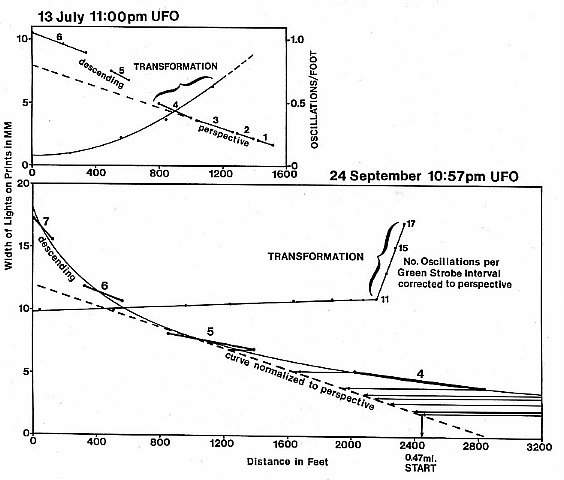
The above graph shows a comparison between rate of change in oscillation and apparent flight paths for two AOP: One on 13 July 1992 and the other on 24 September 1992.
The AOP described at the top of the graph lifted off from a field about 1/3 mile from the camera, and climbed as it approached four observers. The lights spiraled rapidly at first, but gradually slowed in rate until the lights were nearly straight lines (see composite image below). It is at that point that the 13 July AOP began to lose altitude and level off, similar to the 24 September AOP.
Graph No. 3, showing flight path and details of irregular oscillations.
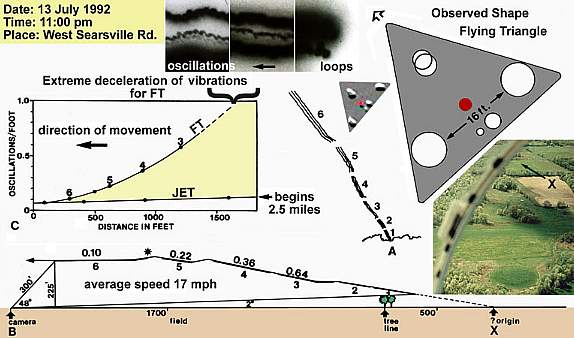
The composite image below shows the 13 July AOP rising above tree line, as well as its unusual flight path and behavior. The AOP appears to have lifted off from a field behind the tree line (marked X in above graph). As it approached the camera it brightened both of its lights, then dimmed them, then brightened its right light, which was then dimmed gradually.
To hear Ellen and Rick comment on what happened as this craft came towards us, play the following wav file.
To download g13jul92.wav (106K), click on The Approach.
The asterisk in that graph above marks where sound from the AOP is first heard in the video (taken by Ellen Crystall). The sound resembles that of a conventional jetliner, but it consists of at least 27 distinct or separate frequencies, combined to produce a single sound. In other words, the sound is synthetic or fake (like that of a midi). It even has a fake Doppler sound of a high-pitched whine (3-4 kHz) dropping too suddenly in pitch just as the craft reached our position (just before 25 Sec below). Listen to the sound and look at the frequency spectrogram.
To download e13jul92.wav (82K), click on AOP Sound.
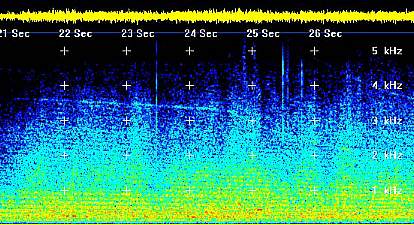
The time exposures taken by Cornet are shown below.
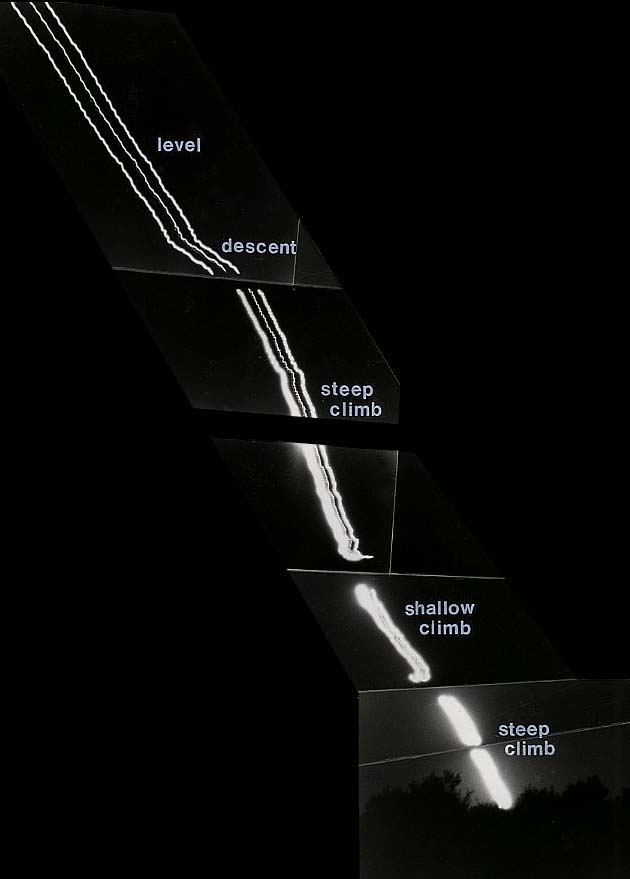
The 24 September 1992 event represents a unique example of what has been reported by witnesses: An anomalous object or set of lights transforms into what seems like and sounds like a conventional aircraft (e.g. Crystall: Silent Invasion, 1991). Without the detailed photographs presented above, such anecdotes are quickly and justifiably dismissed by skeptics as examples of either misidentifications or hallucinations. But if such a transformation can be photographed and documented as it has been here, it is neither a misidentification nor an hallucination.
The lights of this AOP show behavior captured in the photographs unlike anything that a conventional aircraft can produce. Aircraft lights do not spiral and loop. Aircraft lights do not change intensity by several orders of magnitude. Aircraft lights cannot ionize the air to produce ribbons of brown Nitrous Oxide gases. Aircraft strobes fire regularly and are symmetrical; they do not fire irregularly, nor are they asymmetrical in pattern of firing (double strobes on one side; single strobes on the other). Aircraft hazard lights are green and red, not blue and red. The blue color might be due to incorrect printing, but when the color changes from blue to green in the same photograph as the spiraling ceased, one could suspect a color shift due to some sort of a change in ionization. The same shift from blue to green was observed for the Boeing-shaped AOP described in Special Agent 707, when its lights stopped doing spirals and loops.
The light pattern observed for the AOP is shown in Graph No. 1. A single large light was positioned in front. Two small white lights, one behind the other, were observed at the rear of the AOP. No wings were observed when the object was directly overhead, only a stealth black body. With the correct distance and rate of transformation calculated, it is possible to back calculate the actual width of the outermost lights. Initially these lights were assumed to be wingtip lights, but if this object had no wings, then their distance apart might be much less than the wingspan of a single engine airplane (i.e. about 35-36 feet). Based on an average conversion factor (47/150), the wingspan is reduced to 11 feet. But because the actual distance between strobes on the green/blue line has to be estimated, the maximum width could have been as much as 17 feet. In either case we are dealing with something much smaller than a single engine airplane. Either it did not have wings or it was a small robotic model airplane (possible but unlikely considering the energy requirements to produce plasmas). The width of small FTs seen in the area has been estimated at about 16 feet (see Graph No. 3).
AOP similar to the one photographed on 24 September is shown below. As it approached the camera and turned to its right, its brightness did not vary the way a directional lamp on an aircraft would vary. The omnidirectional nature of this light implies that it was not a lamp, but closer to a ball of plasma, which radiates energy in all directions. Its uneven path is due to a gyrating or spiraling motion as it moved.
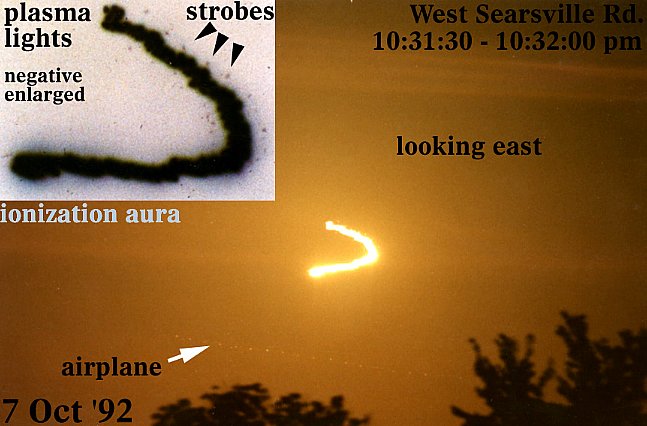
Copyright B. Cornet 1999
Date this web page was last modified: 09/11/25